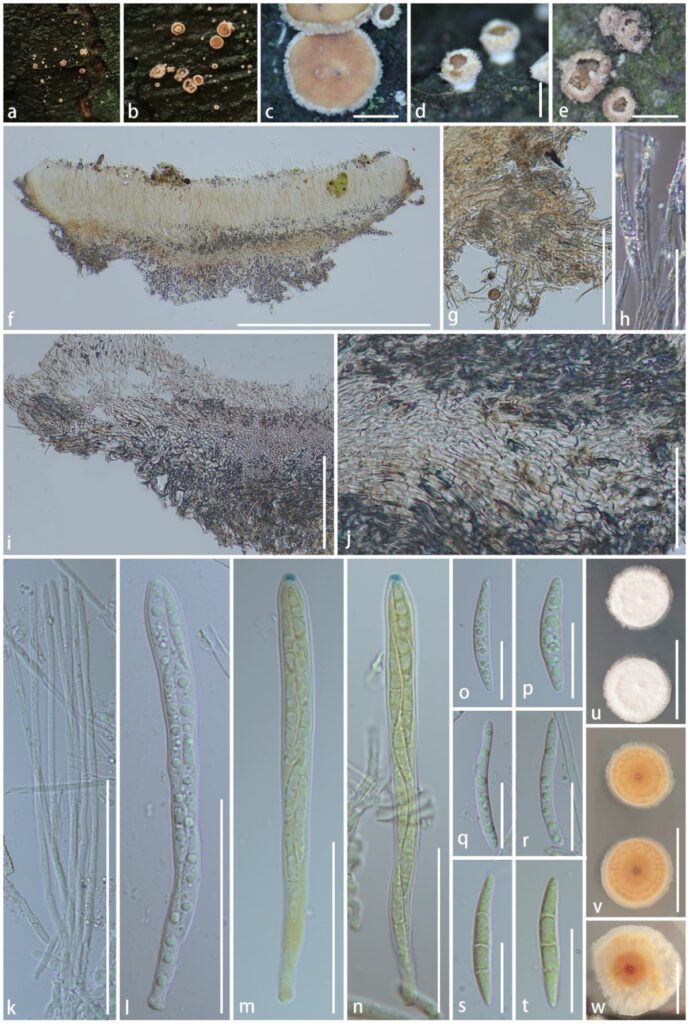Proliferodiscus longisporum C.J.Y. Li, K. D. Hyde & Q. Zhao, sp. nov. Fig. 4
MycoBank number: MB; Index Fungorum number: IF; Facesoffungi number: FoF 12760;
Parasitic on the bark of Liquidambar formosana. Sexual morph: Apothecia 1–2.5 mm wide × 0.3–0.5 mm high (x̅ = 1.7 × 0.4 mm, n = 20 when fresh, gregarious or scattered, disc-shaped, stipitate, growing on the superficial bark or proliferating from the center of the old apothecia. Disc flat and circular with light orange (5A3-5A4) or persion orange (6A6-6B6) when fresh, and brownish-orange (6C8) when dry. Receptacle pulvinate, reddish white to reddish-grey (7A2-7B2) with bushy hairs. Stipe 0.5–0.7 mm wide × 0.1–0.4 mm long (x̅ = 0.6 × 0.3 mm, n = 20), short and broad with white hairs. Hairs 167–185 μm long × 2.4–3.1 μm wide (x̅ = 180 × 2.8 mm, n = 20), rising from the outermost cells of ectal excipulum, cylindric, irregularly curled, hyaline, pale brownish-orange (5A5) on receptacle, white on stipe, septate, thin-walled, smooth, apex covered by irregular hyaline resinous materials. Hymenium 114–128 μm, pale orange (5A3). Ectal excipulum 77–93 μm thick, comprised of thin-walled, hyaline to pale brownish-orange (5A5) cells of textura prismatica, non-gelatinous. Medullary excipulum 110–160 μm thick, comprised of thin-walled, hyaline to pale brownish-orange (5A5) cells of textura intricata, non-gelatinous. Subhymenium not obvious. Paraphyses 2–3 μm (x̅ = 2.7 μm, n = 20) wide, hyaline, filiform, cylindrical, rounded apex, branched and septate at base, extending beyond the asci. Asci 92–114 × 7–10 μm (x̅ = 101 × 8 μm, n = 40), 8–spored, cylindric or subclavate, rounded to subconical apex with J+ apical ring in Melzer’s reagent, tapering to subtruncate base, observed croziers at the stipitate base. Ascospores (21–)22–30(–40) × (2.9–)3.1–4.3(–4.7) μm (x̅ = 25.5 × 3.7 μm, n = 100), Q = (4.8–)5.5–9.1(–10) μm, Qm = 7.0 ± 1.1 μm, overlapping uniseriate or biseriate, fusoid-clavate with blunt ends, hyaline, slightly asymmetrical and sinuous, thin-walled, smooth, 0–3-septate, with multiple granules in the living state and four or more large guttules when dry.
Asexual morph – Undetermined.
Culture characteristics – Colonies growing on PDA medium, reaching 3 cm diam. in 6–7 weeks at 25℃, circular, umbonate elevation, entire margin, rough surface, white mycelia in the front view, reverse view brownish-yellow in suitable humidity and some red mycelium appear in medium with low humidity, white at the margin, center dark brown; no sporulation.

Fig. 4 Proliferodiscus longisporum. a–d Fresh ascomata on the bark. e Dried ascomata on the bark. f Vertical section of ascomata. g–h Hairs. i–j Excipulum. k Paraphyses. l–n Asci (m–n Asci in Meltzer’s reagent). o–t Ascospores (s–t Ascospores in Meltzer’s reagent) u–w Colonies on PDA. Scale bar: c = 1 mm, d = 500 μm, e 1500 μm, f = 600 μm, g = 100 μm, h = 30 μm, i = 100 μm, j = 40 μm, k = 80 μm, l = 50 μm, m–n = 40 μm, o–t = 15 μm, u–v = 3 cm, w = 1.5 cm.
